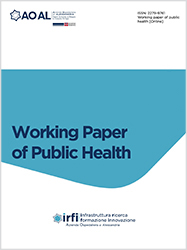Alessandria Biobank: origins, evolution and future scenarios

Accepted: 19 July 2022
All claims expressed in this article are solely those of the authors and do not necessarily represent those of their affiliated organizations, or those of the publisher, the editors and the reviewers. Any product that may be evaluated in this article or claim that may be made by its manufacturer is not guaranteed or endorsed by the publisher.
A biobank, in general terms, is described as a facility aimed at the collection, management, preservation and distribution of biomaterials and related data for genetic research purposes.
The term biobank thus refers to a range of activities carried out by biobanks that differ in nature, objectives, business models, outcomes, and social, political, and scientific impact.
Given the interaction between the biomaterial and associated data, biobanks represent a bridge between the evolution of personalized medicine and the preservation and improvement of public health, in light of the role they play in allowing precisely the preservation of a significant amount of both biomaterial and related data, necessary for the advancement of biomedical research.
At the Research Training and Innovation Infrastructure of the Azienda Ospedaliera SS. Antonio e Biagio e Cesare Arrigo is located at the Centre for Biological Collection (CRMB), which includes the collection of malignant mesothelioma (BB-MM), established in 2005, the collection of breast carcinoma, established in 2021, and the Biorepository established in 2016 to ensure high levels of quality and safety in the field of storage and preservation of biological samples required by protocols of clinical trials and/or intended for research activities.
It is configured as a service and non-profit unit aimed at collecting, storing and distributing biological samples for scientific research purposes while strictly guaranteeing the rights of the subjects involved.
This study aims, in line with the evidence provided by the scientific literature in the field of biobanking and biomedical research, to describe the history of biobanking and, in parallel, the evolution of Alessandria Biobank, between institutionalization and results achieved, to increase the knowledge of the biobank and its work.
Hewitt R, Watson P. Defining Biobank. Biopreserv Biobank. 2013;11:309–15. DOI: https://doi.org/10.1089/bio.2013.0042
De Souza YG, Greenspan JS. Biobanking past, present and future: responsibilities and benefits. AIDS 2013;27:303–312. DOI: https://doi.org/10.1097/QAD.0b013e32835c1244
Loft S, Poulsen HE. Cancer risk and oxidative DNA damage in man. J Mol Med 1996;74:297–312. DOI: https://doi.org/10.1007/BF00207507
Liu AG, Pollard K. Biobanking for personalized medicine. In: Karimi Busheri F (ed.), Biobanking in the 21st century. Advances in experimental medicine and biology. Vol. 864. Springer, Berlin Germany. 2015. p. 55–68. DOI: https://doi.org/10.1007/978-3-319-20579-3_5
Zika E, Paci D, Braun A, et al. A European survey on biobanks: trends and issues. Public Health Genomics 2011;14:96–103. DOI: https://doi.org/10.1159/000296278
Coppola L, Cianflone A, Grimaldi AM et al. Biobanking in health care: evolution and future directions. J Transl Med 2019;17:172. DOI: https://doi.org/10.1186/s12967-019-1922-3
Olson JE, Bielinski SJ, Ryu E, et al. Biobanks and personalized medicine. Clin Genet. 2014;86:50–5; DOI: https://doi.org/10.1111/cge.12370
Meslin EM, Garba I. Biobanking and public health: is a human rights approach the tie that binds? Hum Genet 2011;130:451. DOI: https://doi.org/10.1007/s00439-011-1061-2
Skloot R. La vita immortale di Henrietta Lacks. Adelphi, Milano, Italy. 2011. pp. 424.
Hooper E, Hamilton WD. 1959 – Manchester Case of Syndrome Resembling AIDS. The Lancet 1996;348:1363-5. DOI: https://doi.org/10.1016/S0140-6736(96)07063-8
Betta PG, The malignat mesothelioma biologic bank of Alessandria (Italy). Epidemiol Prev 2010;34:53-5.
Harati MD, Williams RR, Movassaghi M, et al. An introduction to starting a biobank. Methods Mol Biol 2019;1897:7-16. DOI: https://doi.org/10.1007/978-1-4939-8935-5_2
Supporting Agencies
NonePAGEPress has chosen to apply the Creative Commons Attribution NonCommercial 4.0 International License (CC BY-NC 4.0) to all manuscripts to be published.

 https://doi.org/10.4081/wpph.2022.9522
https://doi.org/10.4081/wpph.2022.9522




